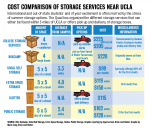It’s that time of the year again. The flowers are blooming and there is a palatable buzz of excitement among newly anointed Bruins and current quarter-wearied Bruins alike.
While high school seniors all over the world are dreaming of the day when they finally become adults and start college, we are excited for a different day – a day that is now less than a month away.
Yes, I’m talking about June 16 – the last day of spring quarter, the glorious date that marks our freedom from midterms, essay deadlines and washing our own laundry for the next three months.
However, for out-of-state and international students, this excitement is marred by anxiety over summer storage issues; after all, no matter how hard we try, there is only a limited number of things that can be stuffed in two suitcases.
Summer storage is an obvious source of anxiety because of the price of storage facilities and uncertainty over storing conditions – no one wants to discover that their belongings have been devoured by mold or fungus come September. But fear not. The Daily Bruin has compiled a table of potential storage services that are near the UCLA campus.
In addition to the table, here are a few tips to protect your beloved belongings from damage, termites, mold or fungus.
Choosing a storage facility
- Unless you have bookcases, sofas or other sturdy furniture, the smallest available space – the 5×5 option – is the best and cheapest option for students.
- Be aware of hidden costs such as potential transportation or Uber costs for transferring boxes while choosing a storage facility.
- Try and visit the storage facility in person before booking a space to ensure that the facility has enough space and is well-ventilated and dry.
- Most storage facilities offer discounted rates on their websites so book the space online after scouting the location.
- Check if your storage facility offers storage insurance.
Storing belongings
- Wash or dry-clean any clothes that you plan to leave behind to minimize the chances of fungus or mold growth.
- Store clothes in plastic boxes or new cardboard boxes.
- Wrap delicate items with bubble wrap before placing them in the box.
- Clean the mini fridge and the microwave before storing them in the facility, and leave the appliances’ doors open for ventilation.
- Place books horizontally to ensure that their spines don’t get damaged.
Packing items in boxes
- Place the heavier items in the bottom of the box.
- Use a lot of filler material to ensure items don’t get damaged. Don’t use newspapers as fillers because the ink on the newspapers may stain belongings.
- Leave a 1-inch margin from the top of the box, and pack this area with filler material
- Label boxes to make the unpacking process easier.
These actions will act as buffers for any potential damage to your belongings and hopefully ensure that after three months, you find your belongings in the same condition that you left them. After all, the end of summer break and the return to the quarter system is upsetting enough without discovering that over break your favorite sweater became the favorite snack of rats and mold.
